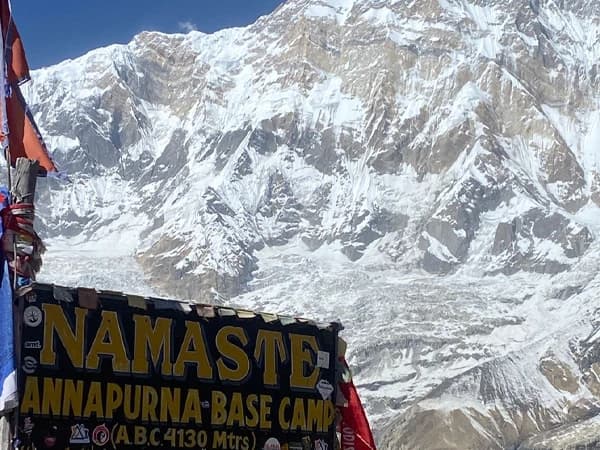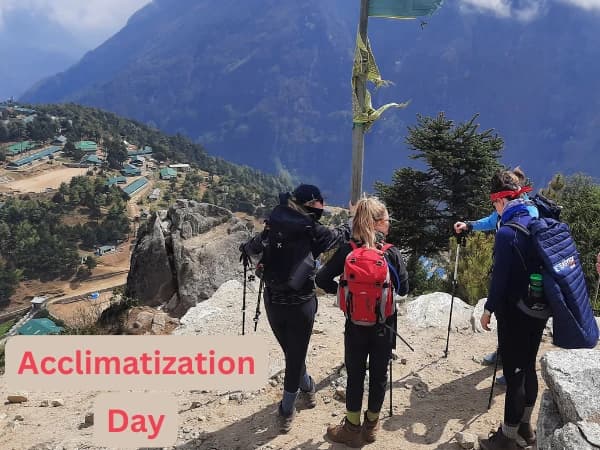Flights to Lukla from Kathmandu and Manthali Ramechhap
Have you ever thought that one flight and one trail could lead you to the heart of the world's highest Himalayas? Did you know you can see Mount Everest from inside the plane during your Lukla flight?
“How long is the flight to Lukla?” KTM - Lukla Barely 45 minutes. In those 45 minutes, you’ll see ancient mountain valleys, glacial rivers, and finally the high Himalayan walls ahead.
Flights usually take off early from Kathmandu, and during the high season like March - May, and October - November flight will be from Ramechhap to Lukla. and land transportation to Ramechhap from Kathmandu.
To get to Ramechhap you have to catch the early transport drive from Kathmandu like 1:15 am, optional transportation like sharing jeep, or private jeep to Ramechhap from Kathmandu, which is about 4 to 4:30 hrs, drive.
You will enter another dimension of the highest Himalayas of the entire Earth, when you leave Kathmandu for Luka fight. Airlines that commonly operate the route include Nepal-registered mountain carriers; flight schedules shift with seasonality and demand, and cancellations are common, so plan buffers.
The ride to Lukla feels like a scenic mountain flight in Nepal more than a routine trip. Here’s the thing about flights to Lukla from Kathmandu — early morning departures have the highest chance.
Pilots prefer clearer skies before the midday winds rise. Still, cancellations are common. Sometimes you wait for hours, sipping instant coffee in the domestic terminal.
Short Runway in the Himalayas Everest
The short runway in the Himalayas with a field‑strip perched on a mountainside, barely 527 meters long, a steep slope, clouds gathering, with sheer cliffs is why this airport is legendary.
The runway at Lukla isn’t long by any commercial airport standard. It’s about roughly 1,729 feet long. Pilots must land uphill and take off downhill. On departure, you accelerate downhill; on arrival, you’re climbing into a slope. Add in mountain winds, rapidly changing weather, low cloud and mystical high Himalayas.
That short runway isn’t just a physical trait—it’s the gateway to highest mountain Everest in the entire world.
Why it’s Built that Way Lukla Hillary Airport
Lukla Tenzing Hillary Airport is very small, Why weren’t bigger airports built, with longer runways? The terrain is brutally unforgiving. Flat land is rare; steep slopes, deep ravines, high cliffs, Himalayan giants everywhere.
To get “long runway,” you’d need engineering on a staggering scale—terracing, blasting and filling. It costs skyrocketing where environment will be heavily disturbed. So, the runway at Lukla is as much a concession to geography as it is to human ingenuity.
How Pilots Handle it in Hillary Airport in Lukla
Flying into Lukla Hillary Airport is an art. Pilots trained specifically for STOL (Short Takeoff and Landing) operations, with hours logged in mountain flying. They watch wind shear, slope, visibility.
Early morning is the golden hour—a window of relative calm before thermal updrafts, cloud build‑up, and turbulence. If visibility falls, flights are delayed or cancelled entirely.
What to Expect When Flying into Lukla Airport for Everest
You depart Kathmandu, banking south past terraced hills, rivers glinting like veins of silver. The plane rises, your ears pop, cloud patterns shift, and then the magic of Himalayas begins to show off.
Jagged peaks with snow fields, steep valleys, high rolling hills, dense forest. Somewhere in between, the plane levels, propellers humming. Mountains close in with hills, high cliffs nearby.
You approach over ridges, sometimes through patches of cloud, then suddenly you see the runway. It sits like a landing pad carved into a mountain’s side.
Lukla airstrip is designed for short-takeoff and landing aircraft. Pilots fly visually and almost always schedule flights for early morning because the mountain winds typically change by mid-day.
Airlines often cap checked luggage (commonly around 15 kg with hand bag) so 10 kg of checked luggage, flights are weather-sensitive (cancellations/delays may happen), and the airport has few services by city standards
While landing you can see stone walls carved with mantras, prayer flags, small traditional mountain villages, and steep paths zigzagging up from the window. The air smells of wood smoke, yak dung, and cold.
Choose the window seat, left or right, depending on airline routing, for better panoramic views of the highest mountains of the earth. Bring a camera with a wide lens.
Scenic mountain flights in Nepal
From inside the plane you can see million dollar views of Mount Everest, Cho Oyu, Thamserku, Ganesh Himal, langtang Lirung, Shishapangma, Gauri Shankhar, Lhotse, Makalu, The Ganesh Himal range, Jugal Hima range and many more.
Flying into Lukla offers views many trekkers never forget. Below you, rivers cut canyons; lush terraced farms give way to birch and rhododendron forest; then beyond tree line, jagged snow ridges. Sunlight hits peaks golden, shadows dipping into valleys. Clouds float below you sometimes.
Mornings are better with light, clearer skies, and fewer delays. Later in afternoon, clouds build up. Plan arrival early in the day so you have daylight to sort gear, rest and wander around heavenly viewpoints.
Spiritual Path of Everest: The Energy of the High Himalayas Everest
What spiritual secrets lie hidden along the trail to the world’s highest peak?
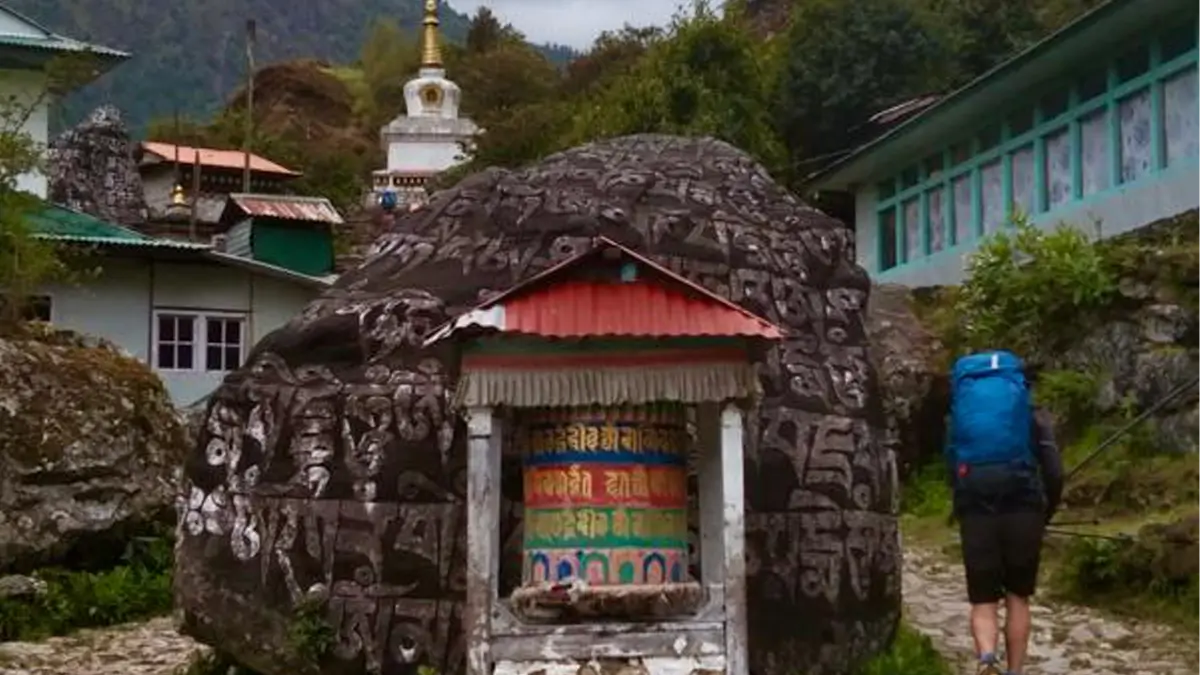
The raw Himalayan giants radiate a kind of presence and raw high Himalayan energy.
From the moment you step onto the trail, prayer flags flutter. Each prayer flag carries a mantra, and with every gust of wind, those mantras travel, blessing all beings. Walk further and you’ll notice Mani walls—long stone structures carved with “Om Mani Padme Hum.”
Some trekkers walk barefoot for a few steps in certain holy spots, believing the earth here holds a different vibration. The ground may be frozen, but the connection is real.
Try it once, and you’ll feel a current through your bones, like the Himalayas themselves are pulsing. They call these mountains the abode of gods.
You whisper your own promise into the thin air, and whether you return to climb higher or not, Everest remains with you.
practitioners come here for sunrise meditations, and they describe the Himalayas as amplifiers, magnifying whatever vibration you bring. Imagine a sun salutation at dawn, Everest glowing above you. Imagine meditating while monks chant in Tengboche Monastery, incense twisting into the air.
Trekking route to the top of the world, EBC – Everest
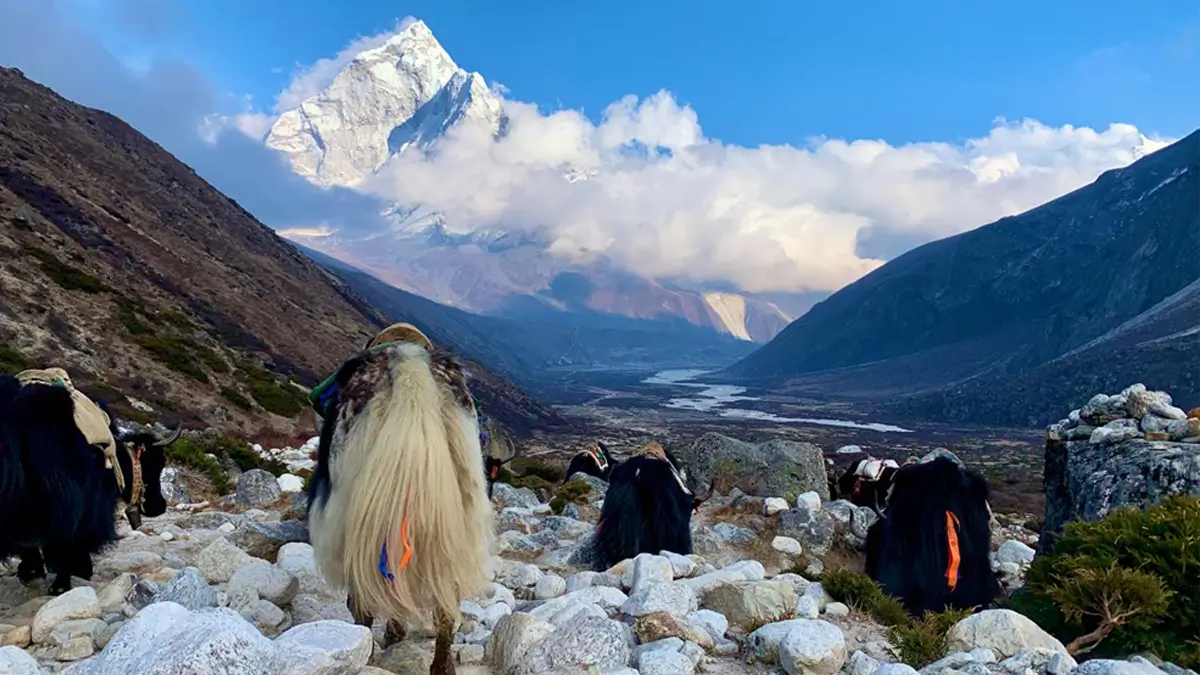
Trekking to EBC – Everest from Lukla (2,860 m), the first day you descend slightly, down to the banks of the Dudh Koshi River and then steadily upward. crossing rhododendron forests, crumbly cliffs, small streams, until you reach Phakding (~2,610 m).
Villages here are modest: teahouses, prayer wheels, friendly locals, and children playing. It’s gentle, lush, vivid and green.
Then proceed to Monjo, a gate into Sagarmatha National Park. Trails narrow, become rockier. Forests thin; views begin opening. Bridges over rushing rivers, yak caravans, fluttering flags, and the smell of wood smoke in the evening.
Jorsalle is next: stone walls, stoic cliffs, the sound of glacier river below. Then you climb to Namche Bazaar (~3,440 m). This section is steep—many switchbacks, the air thins. At Namche, You rest and acclimatize. You see Everest, Lhotse, Ama Dablam, and other high Himalayan peaks in silhouette.
You watch clouds spill off ridges. Villages here bustle: shops, bakeries (yes, real bakeries), banks, wifi spots (spotty but present), guesthouses. You’ll cross the famous suspension bridges festooned with prayer flags — the kind of bridges you’ve seen in National Geographic, swaying over emerald torrents.
Beyond Namche, onto Tengboche (3,868m), Dingboche (4,410m), Lobuche (4800m). The final stretch leads to Gorakshep — the last settlement before EBC.
From Gorak Shep (5,164m), trekkers hike across a glacial moraine, stepping Khumbu Icefall to reach theworld’s highest base camp, a rugged amphitheater of ice and stone beneath the highest peak on Earth.
Early-morning climb to Kala Patthar rewards you with front-row million-dollar sunrise view of Everest’s towering summit like Mount Everest (8848.86m), Lhotse (8,516m), Nuptse (7,86m), Changtse (7,543m),
Each village higher reveals a new layer of the Himalayas’ personality. The altitude increases. Air is colder. Nights are long. Trail conditions get magical: snow, loose rocks, glacier debris. Every step demands care.
Everest Base Camp: World’s Highest Base Camp
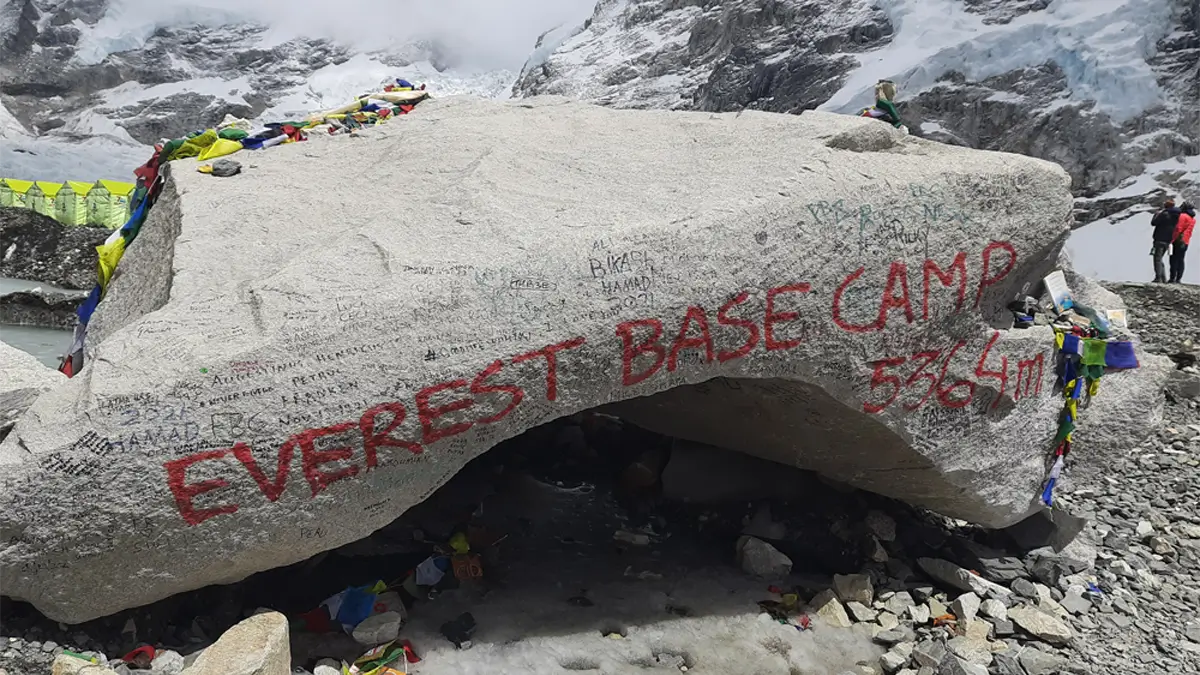
Ask ten trekkers what Everest Base Camp felt like, and you’ll get ten different answers. Some recall the sound—the deep cracks of ice shifting across the Khumbu Glacier. Others remember the color: bright tents speckling the gray moraine like confetti against stone.
EBC is the doorstep of the highest point on earth. Climbers, Sherpas, legends of survival and tragedy, they all begin here.
Dingboche sits in an alpine bowl where stone-built homes battle wind and cold; Lobuche’s skeletons of cairns and memorials remind trekkers that the mountains demand respect.
The Khumbu Glacier sprawls beside the trail, creaking and groaning as it moves, its surface a chaotic landscape of ridges, crevasses, and frozen waves. Gorak Shep (5,200m) is the staging ground — a spare, high camp from which you push to EBC at 5,364 meters.
The geography shifts from lush forests and roaring rivers to barren, windswept valleys carved by ice over millennia. Vast glacial plains, jagged ridgelines, and sweeping Himalayan vistas stretch in every direction.
Along the tranquil forested trail we can witness jaw jaw-dropping panorama of Himalayan giants like Mount Everest, Lhotse, Nuptse, Pumori, Ama Dablam, Makalu, Cho Oyu, Thamserku, Cholatse, Island Peak, Lingtren, Changtse and many more.
Everest Base Camp is the destination most people dream of, the Everest Three Pass Trek is for those who crave crossing high passes, challenging more than arrival. It is for those who want to circle, to witness the Khumbu from every possible angle.
Kalapatthar: Where the Sun Touches Everest
And there’s Kala Patthar (5550m), the unsung hero of the entire trek. Kala Patthar is where the gods show their faces. It’s not a technical climb—just a hill compared to the giants around—but at over 5,500 meters, every step feels like heaven.
You pause every few meters, every possible spot witnessing million - dollar view of the mystical high Himalayas. Many people cry out of happiness when they see panoramicviews of the world’s highest mountain of the entire Earth. First light spills across the mountains. Lhotse glows gold. Nuptse sharpens into shadow.
And finally, Everest itself, Chomolungma, the “Mother Goddess of the World,” emerges in pink-orange fire. No photograph comes close.
People cry here. Some kneel. Some laugh in disbelief. I remember just standing there with numb fingers, whispering “thank you” without even knowing who I was thanking.
Geology of EBC – Everest
The geography of the Khumbu is dramatic and direct. In a matter of days, you pass from temperate valleys to high alpine scree. That rapid transition is what makes the trek accessible yet demanding. The terrain you’ll walk on is geologically active and dramatic.
You’ll be walking on stories written in stone, carved by ice, time, and tectonic collisions. Knowing geology doesn’t just feed curiosity—it roots your journey
You can witness young mountains rising high beyond clouds. The trail Eve up with sedimentary rock, metamorphic stuff and hidden cave faces full of high vibration of energy.
The trek is a lesson in ice. Moraines tower like frozen dunes. For adventure junkies, photographers, travel enthusiasts, spiritual trekkers, researchers, and geologists, this is a living classroom.
Even now, uplift continues; mountains are still growing (very slowly), valleys still deepening. You will journey through glaciers, carving cliffs, moraines piling debris, glacial-fed rivers, and hidden spiritual caves through high alpine Himalayan terrain.
Landing in Lukla Experience
That moment when the world of Kathmandu bustles, honking horns, busy shops, tight alleys, gives way to the highest Himalayas of the entire world, prayer flags snapping in cold wind, yak bells, sky-sharp ridges, feels like heaven.
It is both the literal runway touching Everest’s shadow and the figurative portal into one of the world’s most magical trekking experiences. The short runway in the Himalayas looks almost like a narrow strip carved into the mountain.
One side? A wall of rock. The other? A deep valley. The plane touches down at an uphill angle, and for a second you feel your heart stuck in your throat. But then—relief, excitement, tears of happiness, even laughter. Every passenger claps. You’ve arrived, and you’re already part of the story.
Weather at Lukla – The Unpredictable Gatekeeper of Everest
If there’s one thing every trekker learns before setting foot in Lukla, it’s this: the weather is the boss. Not the airlines, not the trekkers, not even the Sherpas. The skies above the Himalayas decide who gets in and who gets stuck.
Honestly, I still remember my first morning in Kathmandu, bag packed, ticket in hand, staring at the departures board — “Flight to Lukla: Delayed.” Hours felt like days. That’s the nature of weather at Lukla.
Lukla sits at 2,860 meters. Flights can’t gamble here — the runway is short, perched on a slope, with mountains hugging it from all sides. Pilots need crystal-clear views.
And it’s not just about Kathmandu or Lukla. The weather in between matters too. The flight path slices right through high rolling hills and valleys, and if clouds build up, the tiny Twin Otters or Dorniers don’t risk it.
For those absolutely pressed for time, helicopter options exist, though at steep prices. A seat-sharing heli can whisk you between Kathmandu and Lukla, bypassing delays when weather allows. But even helicopters bow to the mountains; when fog grips the valley, no machine flies.
Clouds, wind, low visibility — all can force delays or cancellations sometimes. Pilots don’t want to dance with fog and gusts when the runway itself is only 527 meters long. That’s about a blink if you’re flying at speed.
So, how do you prepare?
Pack for all seasons. Sun hat and sunscreen for the blinding midday rays. A down jacket because evenings bite. Rain cover for your backpack — yes, even in October. And mental flexibility: if your flight cancels, don’t rage, adapt.
Many trekkers now book helicopter seats as backups (costlier, of course), while others pad their itineraries with buffer days. Trust me, those buffer days are gold.
Sagarmatha National Park Entry Permit in Monjo
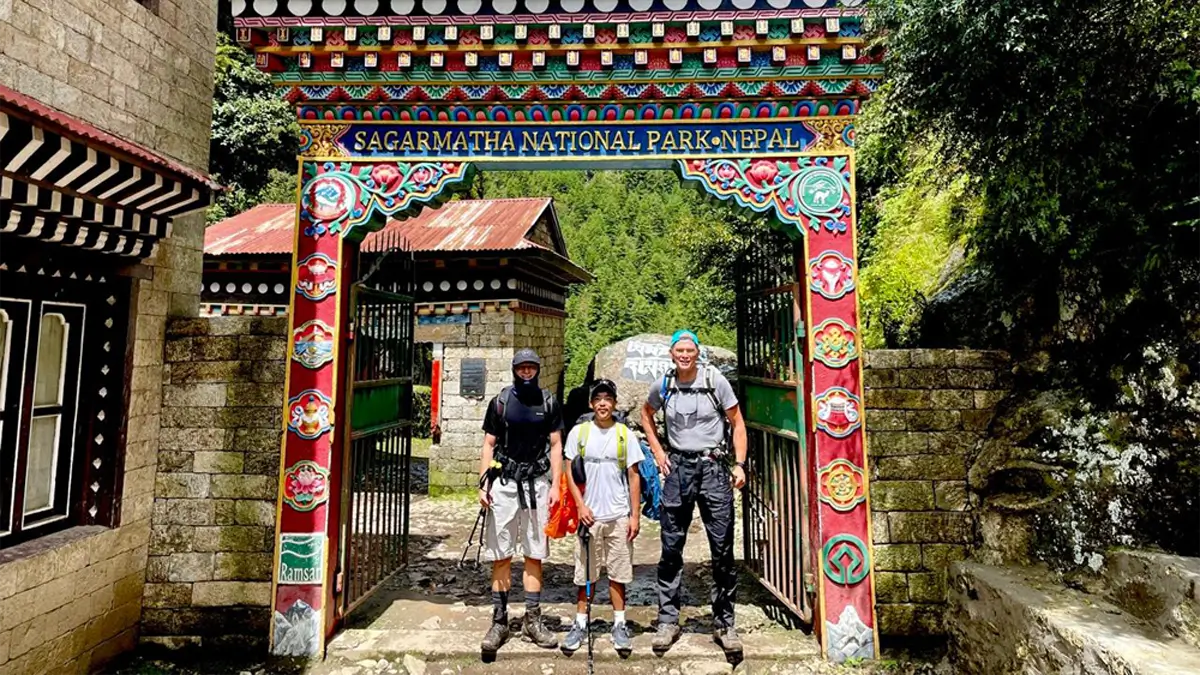
When you cross into Everest sagarmatha National Park, you’re stepping into a UNESCO World Heritage Site, a place of biological diversity, cultural richness, and geological wonder.
To trek in the Everest region you’ll need the Sagarmatha National Park entry permit and local municipality permit — these are checked along the trail and at park checkpoints.
You must have a Sagarmatha National Park permit (obtained in Kathmandu or at Monjo checkpoint) and Khumbu Pasang Lhamu Rural Municipality Permit.
These fees support trail maintenance, local communities’ conservation, hospital posts. The view of Mount Everest from certain vantage points—glacial ice shining, crevasses yawning—makes every permit cost seem trivial.
From Lukla to Namche Bazaar and beyond, you’ll pass rhododendron forests, cold deserts, lush valley floors. Rare birds flit in the canopy; snow leopards sometimes leave tracks.
Khumbu Region Entry Point
If you ever look at a map of Nepal and trace your finger eastward, toward the jagged teeth of the Himalayas, you’ll eventually find a small dot called Lukla.
Lukla is the front door to the Khumbu region, the kind of door you push open and suddenly realize you’re stepping into a different world.
The Khumbu region is the heart of the Sherpa homeland. Lukla is its southern doorway, making it the essential entry point for trekkers. Beyond Lukla, roads vanish completely. From here onward, everything—food, building materials, even oxygen cylinders—must be carried by porters or flown in by helicopter.
For centuries, this was a trade route for salt and grain, long before trekkers arrived with cameras and walking sticks. Every stone has been stepped on a thousand times before you — by monks, by sadhus, local shamans, by yak drivers, by families carrying rice in bamboo baskets.
This isolation preserves the authenticity of Khumbu’s villages. In Namche Bazaar, trekkers find vibrant markets, while in Tengboche, a centuries-old monastery stands against Everest’s backdrop. Without Lukla, accessing this world of towering peaks, glaciers, suspension bridges, and timeless Sherpa culture would be nearly impossible.
Lukla or Namche Bazaar Acclimatization for Trekking?
Landing in Lukla at about 2,840 m (9,300 ft) may not seem extreme compared to Everest’s higher camps, but your body already begins to feel the thinner air.
Trekking from Lukla towards Namche Bazaar is more walking uphill and lots of stairs with stairs climbing. climb in many dimensions: altitude, stamina, even senses. To go fast risks altitude sickness, exhaustion, and regret. To go wisely — that’s where magic lies.
Many trekkers push on immediately and stay acclimatization in Namche Bazaar. Most of the trekking and tour companies mentation the acclimazation in Namche Bazaar and Dingboche. So I’d strongly recommend acclimatization extra night in Namche Bazaar, 3440m, and Dingboche, 4410m.
- Rest, hydrate, and take short walks around ancient Sherpa village.
- Avoid overexertion. Acclimatize slowly. Let your breathing settle.
- Do light activity: walk to the traditional teahouse, sip warm tea, gaze at snow‑capped peaks
- Chase heavenly sunset and sunrise of mystical mountains.
Tenzing Hillary Airport facts
The Tenzing-Hillary Airport is often called the most magical airstrip in the world. The Tenzing Hillary Airport (LUKLA) sits at roughly 9,334 feet (2,845 m) elevation and uses a single, sloped asphalt runway.
The runway is only 527 meters long and tilted uphill at a sharp gradient, making landings dramatic and takeoffs almost theatrical. It was developed with the early support of Sir Edmund Hillary to open the Everest region to safer, faster access.
Pilots here are specialists; they train for years to handle the sudden winds and shifting weather that make flying into Lukla such a white-knuckle experience. And yet, locals will shrug and say, “This is just normal.” For them, it’s not a thrill — it’s everyday life.
Is Lukla Airport Safe?
Yes, Lukla Airpot is absolutely safe. Pilots operating on this route must have special training in short takeoff and landing (STOL) techniques, experience flying in Nepal, and sufficient hours in mountainous terrain.
The pilots flying here are not rookies. They’re some of the most skilled short-runway pilots in the world.
There’s no radar or instrument landing system — pilots must use Visual Flight Rules (VFR), so clear visibility is essential. If visibility drops or winds are too strong, flights simply don’t happen. That’s the beauty and frustration rolled into one: mountain weather controls everything.
Flights are strictly limited to early morning when conditions are typically more stable. If visibility or wind is bad, flights are canceled for passengers’ safety.
Safety Measures in Place
- Nepal’s Civil Aviation Authority mandates specialized training for Lukla pilots.
- Flights limited to mornings; if weather deteriorates, cancellation is enforced.
- Airlines often use small aircraft suited for STOL operations.
- Local authorities monitor runway conditions, maintain slope and safety margins.
Personal Measures You Can Take
- Fly only when clear skies forecast.
- Don’t push if weather looks bad.
- Use credible operators with good safety records.
- Ask around, read recent trip reports.
- Avoid flying in bad weather unless necessary.
- Always have flexible schedule to absorb delays.
Travel Guide For Lukla and Everest Gateway
Arriving in Lukla is both the end of a short flight and the beginning of a trekking rhythm: short treks by day, tea-house evenings, and altitude adjustments that turn simple tasks into expeditions. Here’s the guide your clients will actually read on the plane.
Fly early in the morning. The window for safe flying is narrow—before clouds build and winds pick up.
Packing Smart
Pack light and smart. Airlines flying into Lukla strictly enforce weight limits (usually ~10 kg checked + a few kg carry‑on). Weight is vital. Airlines have strict limits—both for safety and logistics.
Use compressible bags, carry essentials in your pack, bring quality boots, thin breathable base layers, sun protection, compressible clothing, warm jacket, gloves. Rain gear is essential—even dry seasons can surprise you.
Physiological Preparation
Start walking hills, carrying a pack, before you fly in. Your cardio, jogging, cycling, lung capacity, balance—that’s what will carry you. Sleep early in nights leading up to departure.
Eat well. Even something as simple as carrying snacks you like (chocolate, nuts) makes difference when rationed food becomes your staple. Don’t rush. and acclimatize properly
Water Tip: you can buy mineral water bottle or use a SteriPen, or Water tablet for your safe drinking water along the everest base camp trekking trail.
Money & Connectivity Cash rules.
ATMs in Lukla are few. Once you pass Lukla and Namche Bazaar, they disappear. Carry Nepali rupees. Exchange in Kathmandu. Phone service is spotty. Some guesthouses have WiFi or satellite; don’t count on high speed. Bring power bank. Solar chargers help.
Choose reliable airlines. Carry travel insurance that covers flight cancellations, delays, and emergency evacuation.
Trekking Gears and Equipment
Double-check your trekking equipment in Lukla. Need trekking poles? You’ll find them here, though at higher Kathmandu prices. Forgot purification tablets or a headlamp?
Dozens of small shops sell them, though at slightly inflated prices compared to Kathmandu. Shops at Lukla stock basics but not always quality.
Keep documents and permits handy; officials or guides may ask for them around the terminal.
On the Trail
The trekking trail from Lukla quickly becomes a series of ups and downs over suspension bridges, through rhododendron forests, hidden cave faces and past mani walls and prayer flags.
Encourage readers to learn a few Nepali phrases — “namaste” or “Tashi Delek” always opens doors — and to support local porters and teahouse-run businesses.
Craving comfort food before you face the spartan menus higher up? Lukla’s bakeries are surprisingly good, and yes, many swear the apple pie here tastes better than it has any right to at nearly three thousand meters. (Try it. You’ll thank me later.)
Spend a night here if you can. Walk through the lanes, climb the small ridge above town for your first real Himalayan panorama, and let your body catch its breath. The locals will tell you — and guides will echo it — that patience here pay bks off higher up.
Accommodation and Food Options in Lukla
Lukla Airport gateway to Everest trekking introduces you to teahouse culture immediately. Lukla town is full of lodges, cafes, bakeries (yes, bakeries at 2,860m!), and gear shops. Many trekkers stay a night here to adjust.
The teahouse of Everest region is more advance than of other trekking routes. Teahouses and guesthouses offer twin rooms, simple bedding, charging points in dinning room, and Wi-Fi, though gas slower in higher altitudes.
Food ranges from traditional mountain dishes like Tsampa, Shyakpa, Rildok, dal bhat, pasta, noodle, thukpa, fry rice, bread, chapati, potato, rosty, pancake, momo, macaroni to pizza many more. Don’t expect gourmet, but do expect hearty. Expect higher prices due to supply challenges.
Toilet facilities are “mountain standard”: squat or western style depending on lodge, often with composting, western or simple septic.
Everest Trekking Starting Point
There are airports around the world where you simply arrive, grab your luggage, and move on. Lukla is not one of them. Lukla is the Everest trekking starting point, but it is more than just a beginning; it is the threshold between the ordinary world and the high Himalayan dream.
Trekkers often describe the early trail as a soft introduction, where you learn how to adjust your pack straps, how to fall into step with porters, and how to pace yourself for the long journey ahead.
Step off the small plane here and something shifts inside you — the buzz of Kathmandu is gone, the air is thin and crisp, and everywhere you look, there is the Himalayas and mountains, people are either starting or finishing a journey of a lifetime.
From here, every step you take begins to pull you into the Khumbu Valley, through villages that still live by tradition, past suspension bridges fluttering with prayer flags, and eventually toward the icy amphitheater where Everest dominates the sky.
Guided EBC-Everest trek with Sherpas
When you hire a Sherpa guide, you aren’t buying a service; you’re being welcomed into a culture. When you trek in Everest region or EBC with sherpa-led team you are buying decades of centuries old local knowledge. (But hire the guide from the registered trekking tour operator)
There’s a reason people call Sherpas “the mountain heroes.” Without them, Everest expeditions wouldn’t exist. Sherpas are not just hired hands; they are culture carriers, weather readers, and — critically — local safety assets. Book and travel with locally own operator trek and you’re buying layers of value. They open doors you’d never know existed.
Local Sherpas reads the slope, cloud, and the mood of the mountain. They have evacuation contacts, local clinic relationships, and usually prearranged helicopter partners. You learn about their traditions, like the puja ceremonies where climbers ask the mountain gods for permission before expeditions.
Sherpa locals grew up walking these trails, and their lived memory includes seasonal avalanche scars, reliable water sources, micro-vantage points for sunrise photos, and local medical anecdotes.
Why Locally Operated Trekking & Tour Companies for Everest?
One of the best decisions you can make for your Everest journey is to choose a locally operated trekking company. When you pick local, your money doesn’t vanish into a corporate office abroad; it stays in the Khumbu Valley.
It builds schools, funds health posts, pays porters fairly, and sustains communities that have carried mountaineers for generations. Locals know the trails with a memory that maps cannot capture.
Every trip booked through you- the village-runs, company circulates cash where it matters most: in markets, in teahouses, in porter wage’s, in teachers’ salaries. When a porter earns a fair wage, their family can afford schoolbooks stationery etc.
These micro-economies accumulate. In the Everest Khumbu, revenue from trekking supports medical clinics, small hydropower projects, and classroom repairs. Your booking helps run teahouses, pay a porter fairly, and puts food on local tables.
Local trekking operators who live in the valleys have pre-existing relationships with helicopter services, clinic staff, and lodge owners. They’ve evacuated clients before and can coordinate a response quickly. That practical competence reduces both risk and stress.
Why Does this Matter?
Every dollar you spend can either vanish into a foreign agency’s account or circulate within mountain villages, funding schools, health posts, and livelihoods.
A child in Khumjung may continue her education because her father earns a fair wage as a porter. A small clinic in Namche Bazaar may receive supplies because local companies reinvest in community health.
The money you spend on your trek has a multiplier effect, strengthening the very communities that make this extraordinary journey possible.
They are climatologists, ceremonial custodians, load-managers, avalanche-watchers, mountain medics, and storytellers. A Sherpa’s knowledge is both learned and inherited:
Locally operated trekking tour companies care for the trails because they belong to them. Many organize cleanup treks, promote eco-lodges, and teach trekkers responsible practices.
Safety Tips for Lukla Everest Trekking EBC
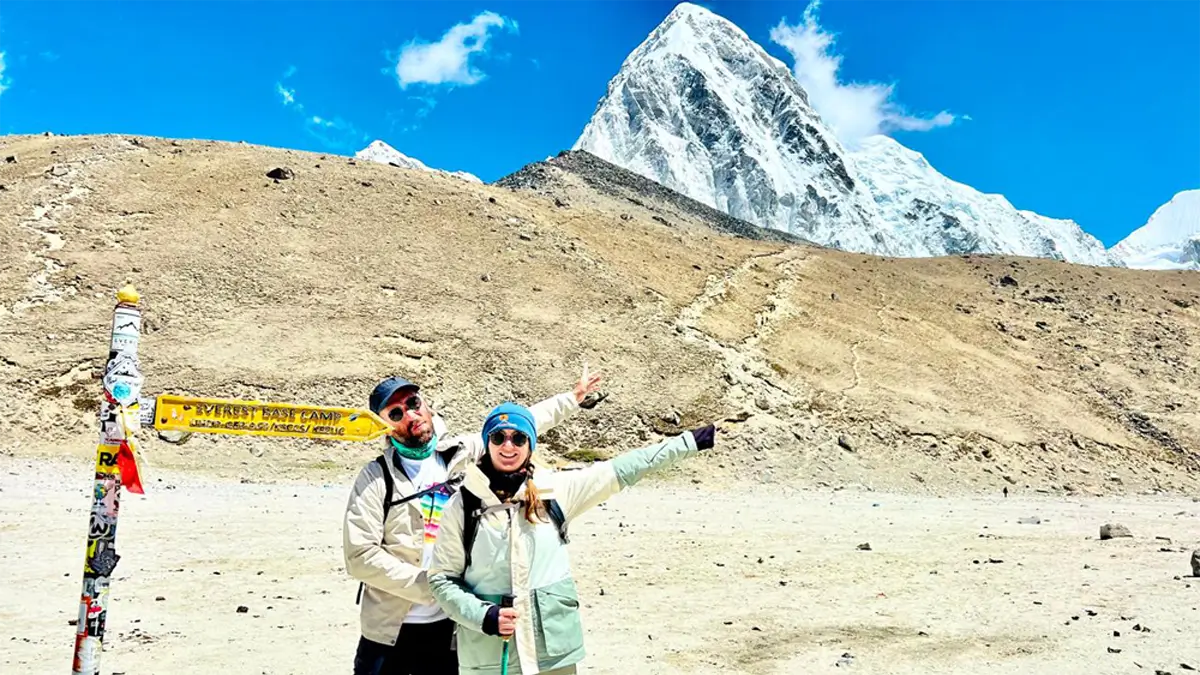
Some of the safety tips about Nepal trekking to Everest Base Camp EBC from Lukla:
- Fly early, stay flexible. Lukla flights concentrate in the morning — schedule buffer days in Kathmandu.
- Always ascend gradually. Acclimatize properly. Spend extra days in Namche Bazaar and follow “climb high, sleep low” principles.
- Hire local guides for safety, cultural connection, and navigation expertise.
- Know the symptoms of Acute Mountain Sickness (AMS).
- Carry basic medicine (acetazolamide, pain relievers).
- Hire experienced local guides. Their knowledge of micro-weather and evacuation options matters.
- If symptoms worsen—breathing trouble, confusion— Tell you guide and descend.
- Pack proper layers: base, mid‑warmth, wind/water protection.
- Leave no trace. Pack out waste and respect local shrine sites and customs.
- Stay hydrated and avoid alcohol at altitude. Dehydration increases AMS risk.
- Use Good boots, broken in. Gloves, warm hat, spare socks.
- Carry Sunglasses, sunscreen—even snow reflects strong UV.
- Use Trekking poles. It helps to balance and reduce strain.
- Morning starts are best. Afternoon typically brings weather changes.
- Know forecast; watch sky. If clouds are building fast, don’t push.
Why Lukla Airport Matters for Nepal’s Economy and Tourism
Lukla Airport gateway to Everest trekking isn’t just about trekkers. It sustains entire communities. From flights bringing supplies to income for guides, porters, teahouses, and shops. Lukla fuels the Khumbu economy.
Without it, tourism in the Everest region would shrink. With it, thousands of families thrive. It’s more than a gateway. It’s a lifeline.
Lukla Airport one of the main entrance gateway to the Everest trekking region opens into a trail that is woven of villages, rivers, forests, snow-dust peaks, high ridgelines and sacred cave faces.
Lukla’s role in tourism creates jobs that are hard to replace — from guide work to lodging and local transport — which is why investment in safer, more reliable aviation operations has social as well as economic return for the region.
Why Lukla to EBC-Everest Route Matters?
Every year, thousands of people trek trails across Nepal — Annapurna Base Camp, Langtang Valley, Manaslu Circuit trek. All of them are beautiful. But the Lukla-to-EBC-Everest Base Camp route matters in a way the others don’t.
It’s the path that carries the weight of history, culture, and something more elusive to the highest peaks of the entire Earth.
This trail is the same one that carried Tenzing Norgay Sherpa and Edmund Hillary toward their 1953 ascent to the top of the world. Imagine that for a second. You’re not just walking a path; you’re tracing history.
This ancient mountain route teaches humility and awe. You learn why altitude matters, why acclimatization saves lives. You see how people live where oxygen is thin.
The villages are not just pit-stops; they are lifelines of culture. Each stone wall, prayer flag, each teahouse shares a story — they stitch together the trek’s magic. It matters because you leave a different person than the one who stepped off the plane at Lukla.
Trekking Permits to Everest Base Camp
- Khumbu Pasang Lhamu Rural Municipality Permit
- Sagarmatha National Park Entry Permit
During the trekking to Everest Base Camp, trekkers need to obtain two different entry permits, like the Pasang Lhamu Municipality and the Everest sagarmatha National Park.
Permits can be arranged in Kathmandu or purchased along the trail. Don’t skip this step — checkpoints will ask for them.
These permits can usually be arranged ahead in Kathmandu or purchased upon walking from Lukla to Phakding. You need to purchase a Khumbu Pasang Lhamu Rural Municipality Permit.
But bringing proof, copies, and passport info helps. Officials at checkpoints (e.g. at Monjo, Phakding, or Namche) will ask for permits. Carry them with you.
And another Everest- Sagarmatha National Park entry permit will be purchased on the 2nd day, walking from Phakding to Namche Bazaar.
FAQs-Lukla Gateway to Everest Trekking
What fitness level is required for Everest Base Camp?
Basic fitness. Expect 5–7 hours of hiking per day with gradual altitude gain. No technical climbing is required. But normal basic exercise like hiking, walking, running, jogging, cycling, etc.
Can I trek solo?
Yes, you can trek solo, but we highly recommend an experienced trekking guide for your safety and easy access along the trek, and also you will learn more about nature, culture, and people.
What’s the best season for Lukla to EBC- Everest Trekking?
You can trek to Everest in all four seasons. All seasons has its own specialty. Spring (March–May) and autumn (September–November) offer the clearest skies and safest conditions.
Do i need trekking permits?
Yes—Everest Sagarmatha National Park and a Khumbu Pasang Lhamu entry permit.
Can beginners do the trek?
Yes, beginners and veteran trekkers can complete the trek with right preparation. Flexable and fitness helps, but mental strength matters more.
Can Helicopters land in Lukla?
Yes, helicopters can land at Lukla.
How do i reach Lukla?
Travelers take a direct short 40 - 50 minutes flight from Kathmandu. and Drive to Ramechhap Manthali Airport and flight to Lukla 12-15 minutes.
During the high season most of the flight will be from Ramechhap to Lukla. And you can also land transport, and trek in from Phaplu or Jiri, though it takes several extra days.
At what elevation do trekkers get altitude sickness?
Normally, over 3500m trekkers might get altitude sickness, but as long as you’re full of energy and mentally prepared, slowly and steadily, no problem.
Is trekking from Lukla suitable for beginners?
Yes, with proper preparation and fitness, beginners can complete the trek, especially with guides and acclimatization days.
Can flights get canceled?
Yes, weather can cause cancellations. Booking flexible flights and adding extra days is advised.
Are there ATMs or internet in Lukla?
Some lodges offer Wi-Fi, and a few ATMs exist, but services can be unreliable — carry some cash.
Can I explore Lukla during the trek?
Yes, many trekkers spend a last night of the trek here in Lukla, before flight back to KTM or Phaplu.
What is the Khumbu region?
Khumbu is the Everest Himalaya region of Nepal, home to Sherpa villages, monasteries, and iconic Himalayan landscapes.
Are there shops and gear rentals in Lukla?
Yes, Lukla has small shops selling basic trekking gear and essentials, though prices may be higher.
Is it safe to fly into Lukla?
Yes, flights are absolutely safe but can be delayed due to weather. Pilots are highly experienced and only fly in good mountain conditions.
Are there accommodations in Lukla?
Yes, you’ll find many teahouses, lodges, and small hotels offering basic but comfortable stays.
Is altitude sickness a risk starting from Lukla?
Lukla sits at 2,860 m (9,383 ft). most trekkers don’t feel altitude effects immediately, but acclimatizing is recommended.







